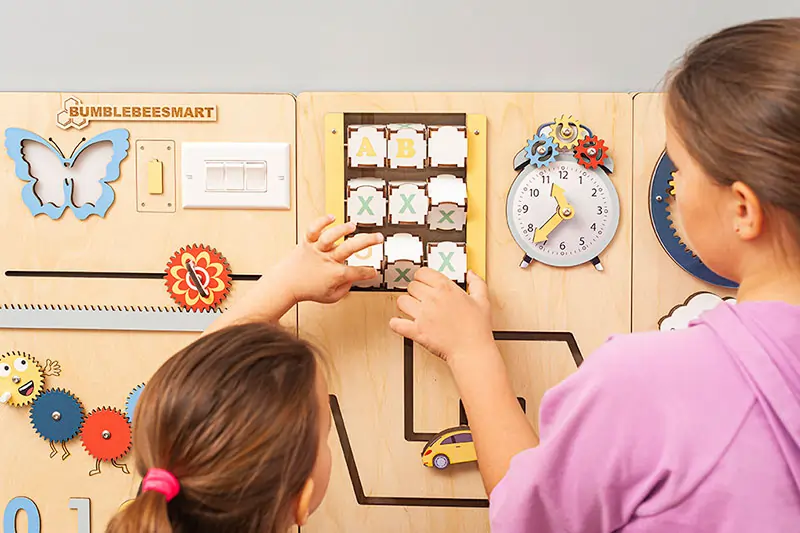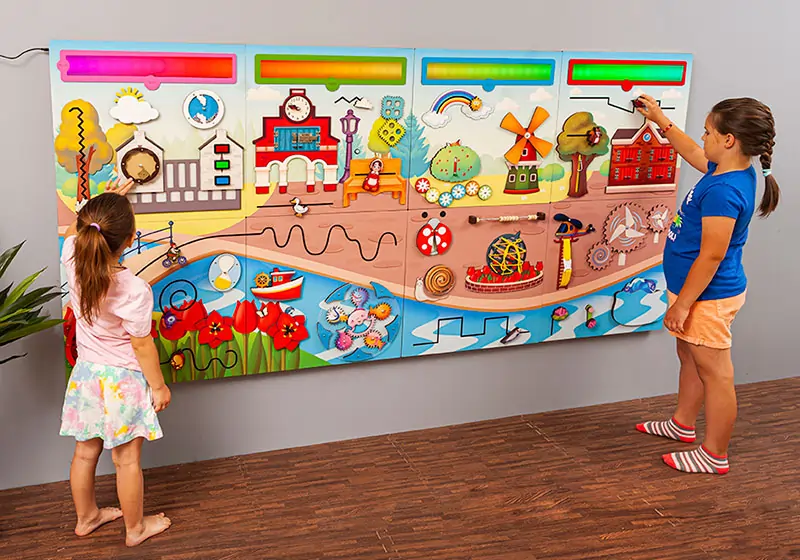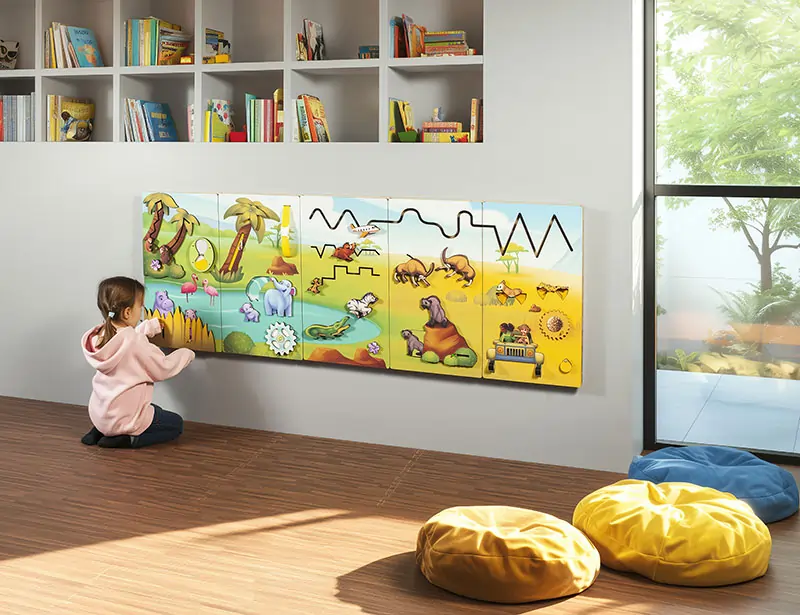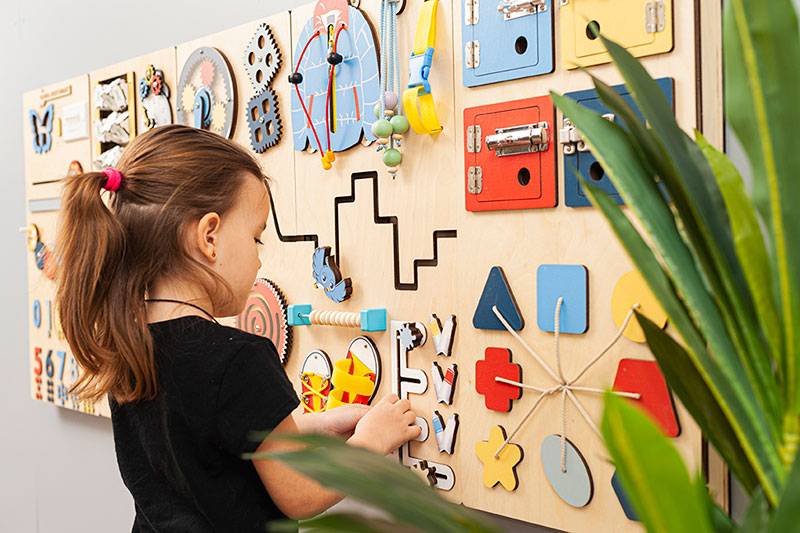Wall-Mounted Sensory Activities That Help Kids Self-Regulate
Self-regulation is the quiet superhero of a smooth school day or a peaceful afternoon at home. It’s a child’s ability to tune in to what’s happening inside, then adjust feelings, focus and energy so the next choice is a better one. Some children learn these skills in a heartbeat. Others need a little scaffolding. That’s where vertical sensory activities come in.
Vertical sensory play offers the brain safe, predictable input through touch, vision, sound and movement. When that input is made available on a vertical surface, it is suddenly accessible in tight classrooms, small bedrooms and busy waiting rooms. Unlike other wall-mounted sensory activities, wall-mounted sensory activities turn an empty wall into a calming, purposeful routine rather than another distraction.
This article shows you how vertical sensory activities calm children’s bodies, clears their minds and gets them back to learning with more confidence. You’ll find concrete suggestions, gentle language and lots of yes-you-can examples for real families and real classrooms.
What Is Vertical Play?
Vertical play is any hands-on activity mounted on a wall or vertical board. Think sensory wall panels, magnetic mazes, sliding tracks, mirrors with tracing prompts, spinners, gears, zipper or buckle stations and simple textured squares. If children can reach it while standing or sitting upright and it promotes safe touch and movement, it counts.
Why not just leave it all on the floor? Because wall play asks the body to work differently. Children use core muscles to stay vertical. Shoulders and upper back become attentive. Eyes must track movement that moves up-down and left-right, which later makes a difference for reading and writing. Hands are coordinated with what eyes are tracking and that coordination serves daily classroom tasks, from copying from the board to lining up numbers in place.

Vertical play is seen in many settings:
- Classrooms and resource rooms, where a quiet area has a number of thoughtfully chosen sensory routines.
- Therapy rooms, where occupational therapists utilize vertical surfaces to build strength and focus without it feeling like exercise.
- Clinic and library waiting areas, where children need something soothing, shareable and easy to disinfect.
- Home study areas, where a small panel can reset energy before homework.
The Science of Sensory Self-Regulation
The brain is constantly listening to the stimuli from the body. Touch, sight, sound and movement provide constant messages: we are relaxed, we are overwhelmed, we are fatigued, we are prepared. When a child runs his or her fingers over a textured square, follows a maze with a finger, or turns a gear in a slow sequence, the brain receives constant, predictable input. That input is a metronome for the nervous system. It is telling the brain slow down, get organized, breathe.
Repeated exposure to touch and visual input makes a habit loop. Children learn that if they do this, it does that and it feels like this. Smooth plastic might be a cue to breathe in deeply once and breathe out deeply once. A slider track might be a cue to move top to bottom, then bottom to top, counting to five both ways. These rituals feel safe. Eventually, children start them on their own when they need a break.
Sensory-rich environments aren’t more, more, more. They’re about just enough. For most kids and especially kids with autism or sensory processing challenges, a few predictable tools decrease anxiety and open the door to attention. Repetition matters. Simplicity matters. The goal isn’t stimulation. The goal is balance.

Advantages of Wall-Mounted Sensory Activities
Emotional regulation. Repetitive wall movements are grounding. Turning a gear, sliding a bead along a path, or tracing bumps with the fingertip gives rhythmic input that reduces stress. Children breathe more normally and drop their shoulders within a minute or two.
Focus and attention. Quick sensory breaks are like a reset button. A child who is tuning out during a lesson can take a 2 to 3 minute vertical routine and then return with more stamina. Teachers sometimes notice fewer cues after those micro-breaks.
Fine motor and cognitive development. Knobs, clips and zippers build hand strength and dexterity. Mazes and paths with patterns teach sequencing and problem solving. Children learn start-to-finish thinking. It’s low pressure, but it will one day assist them in writing a sentence or solving a math problem.
Social and communication development. A shared wall invites side-by-side play. Children take turns, explain what they’re doing and ask for help. Many are more apt to talk when their hands are engaged and their bodies are stationary. Vertical play can be a gradual bridge from parallel play to cooperative play.
A useful tip for adults: benefits appear quickest when routines are brief, predictable and done every day. Think small and frequent, not large and occasional.
Creating Vertical Sensory Spaces in the Home or School
You don’t require an entire wall to have an impact. One square meter, well used, is sufficient. Here are down-to-earth, non-promotional suggestions to begin.
Choose safe, simple, easy-clean materials. Wall-mounted sensory panels are also advantageous as they stay put, save floor space and are impervious to clutter. If you’re up for a DIY project, mount some firm boards and attach fabric remnants, wooden shapes, or simple puzzles. Avoid anything that sheds or is fragile.
Match textures and colors to the child. Some children relax with soft fabrics and warm neutrals. Others focus best with a little sparkle or a bright target to track. Start with three textures at most. Look at the child’s body language. If shoulders drop and breath slows, you’re on the right track.
Create a calm corner or reset wall. This is not a time-out space. It is a self-care station. Post a small, welcoming script on a card:
- Stop and breathe slowly once.
- Choose one thing on the wall.
- Do it for two minutes.
- Return to work.
Keep the environment calm. One small lamp, one small panel, one timer. Less is more. The goal is predictable regulation, not a carnival.
Mount at the right height and leave clear access. The center of the activity should be near the child’s elbow when the child is standing. Clear the path for children with wheelchairs or walkers. Secure all fixtures with the proper anchors for your wall.
Make hygiene possible. Choose surfaces that will stand up to gentle cleaning. Clean high-touch surfaces daily. Check moving parts weekly to make sure everything remains safe and smooth.
A neutral reminder: sensory wall panels can also serve as a fixed point for these short routines. Their consistency makes it clear to children what to do the moment they arrive at the wall.

The Emotional Layer – From Overwhelm to Calm
Children do not necessarily have language for stress. What can look like refusal can be a nervous system looking for salvation. Vertical sensory play gives the body a language that does not need sentences.
Picture a child who’s been holding it together all morning. Noise builds up, chairs scrape, pencils drop, directions change. At the reset wall, the child slides a bead from top to bottom, counting 1 to 5 and back up again. Hands do the familiar. Eyes follow the path. Shoulders drop. No lecture necessary, no label applied. The message is clear: I can calm myself, then try again.
The secret is to use the wall not so often, but as a rhythm of the day. Two planned micro-visits and one as-needed visit can transform the atmosphere of a classroom or homework session. Children love the predictability. Adults love the fewer meltdowns and smoother transitions.
Following is a little routine you can post near the wall:
- Check in. On a scale from 1 to 5, how is your body?
- Choose one path or texture.
- Take a slow walk for one minute. Breathe consciously.
- Check in again. Did your number go down, stay the same, or go up?
- Return to your task with one clear next action.
Small, gentle, repeatable. That’s the emotional layer doing its job.
Conclusion
Vertical sensory play turns walls into quiet helpers. A short, familiar routine can settle emotions, concentrate attention and get the hands ready for learning. This is not an issue of high technology or endless option. This is a case of giving children a safe place to watch themselves, restart and rejoin the day.
Teachers and parents can view wall activities not as toys, but as developmental bridges. They bridge brain work and body awareness. They bridge communication and coordination. They make space for calm, even when the schedule gets crazy.
Where movement, color and texture meet on a bare vertical surface, children simply do what they need to do for a lifetime of learning: stop, adjust, try again. And that is a fine use of a wall.
Author Bio
Andrii Deviatov is the founder of BumblebeeSmart, an edtech company that designs inclusive sensory wall panels and vertical play environments for schools, clinics, libraries, and indoor play spaces. With 14+ years in embedded hardware and product development, Andrii pairs engineering rigor with human-centered design to support self-regulation, fine motor growth, and calmer, more focused classrooms. BumblebeeSmart specializes in wall-mounted sensory systems, custom layouts, ADA-aware accessibility, and durable, easy-clean materials that turn limited space into high-impact learning zones.

